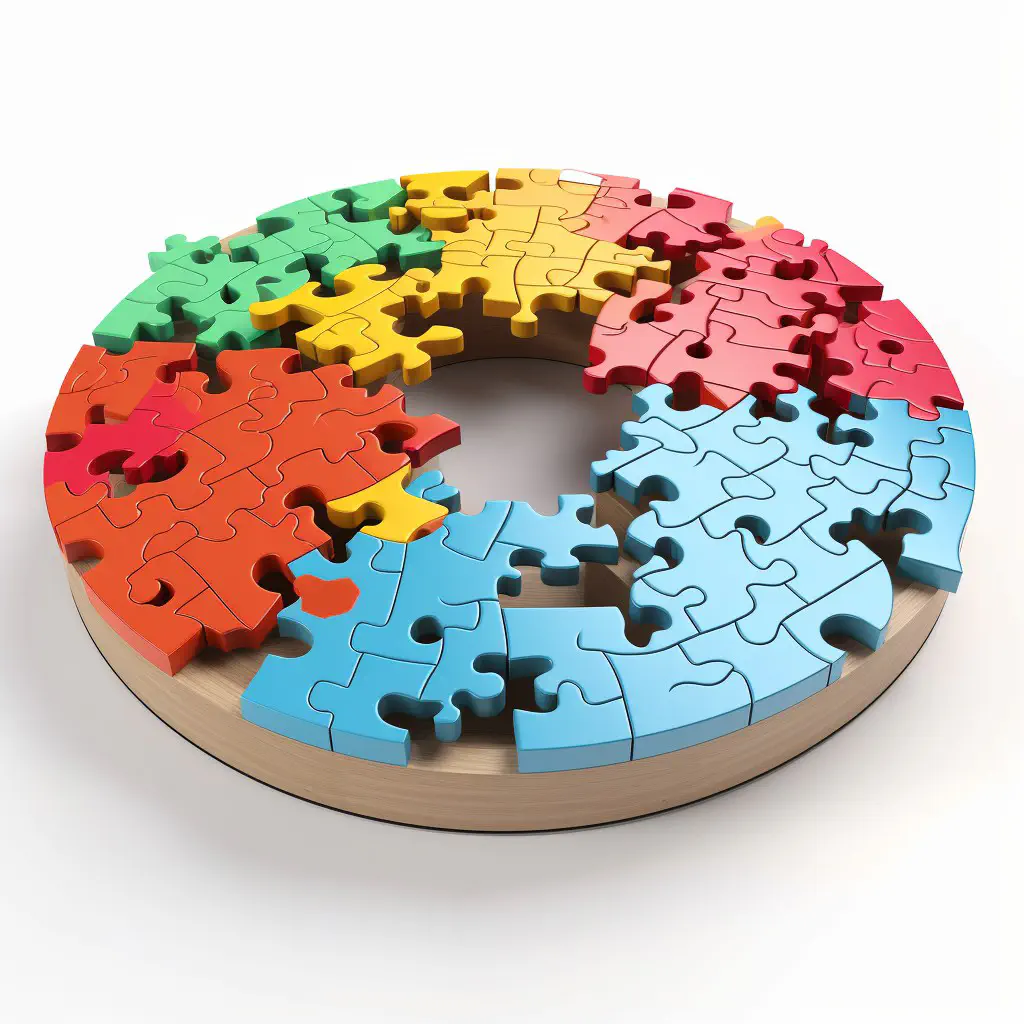
1. Define your dimensions clearly
When conducting multidimensional analysis, it is important to start with a clear definition of what your dimensions are. A dimension is a variable or attribute that you want to analyze. Examples of dimensions might include product categories, customer demographics, geographic regions, or time.
Mutual exclusivity and collective exhaustiveness
When defining your dimensions, it is crucial that they are mutually exclusive and collectively exhaustive. This means that there should be no overlap between dimensions, and that every possible option should be covered by at least one dimension.
For example, if you were analyzing sales data for a clothing store, you might have dimensions such as product category (shirts, pants, dresses, etc.), store location (New York, Los Angeles, etc.), and time period (monthly, quarterly, etc.). These dimensions are mutually exclusive, as a shirt cannot also be a pair of pants, and collectively exhaustive, as every sale would fall into one of these categories.
Defining dimensions with clarity
When defining your dimensions, be as specific and clear as possible. Avoid using vague terms or catch-all categories that could lead to confusion or misinterpretation. If necessary, test your dimensions with a small sample of data to ensure they are effective and accurate.
Finally, make sure your dimensions are relevant to the question you are trying to answer. Don’t include dimensions that are not necessary or do not provide useful insights. By defining your dimensions with clarity and care, you can ensure that your multidimensional analysis is accurate and meaningful.
2. Choose the Right Data Sources
Choosing the right data sources for your analysis is critical to ensuring the accuracy and relevance of your results. Here are some tips to help you make the right decisions:
2.1 Identify Your Objective
Before selecting your data sources, it’s essential to identify the objective of your analysis. This will help you to determine what data points and variables are most critical to your analysis, and will ensure that you choose data sources that align with your goals.
2.2 Consider Your Audience
Consider the audience for your analysis, and ensure that the data sources you choose are appropriate for their level of understanding. If your audience comprises experts in your field, you can choose more complex data sources. But if your audience is more general, choose simpler and more accessible data sources.
2.3 Choose a Variety of Data Sources
Using a variety of data sources is a great way to add depth and context to your analysis. Ensure that you choose sources that offer different perspectives, such as internal data, third-party data, social media, or survey data from customers or partners.
2.4 Evaluate the Quality of the Data
Before using any data source, it’s essential to evaluate its quality carefully. Check for accuracy, completeness, and consistency. Ensure that the data is up-to-date, relevant, and reflects the period you want to analyze.
2.5 Check Data Availability
Ensure that the data sources you select have the data you need to support your analysis. This includes checking the availability of the data, the frequency of updates and ensuring continuity in data.
2.6 Consider Data Integration
Finally, consider how you can integrate data from various sources to provide a more comprehensive picture of your analysis. This may involve combining structured data sources (such as databases) with unstructured data sources (such as social media data) or conducting Natural Language Processing (NLP) to analyze data in a more granular way.
By following these tips, you can ensure that you choose the right data sources for your multidimensional analysis, making it more accurate, actionable, and insightful.
3. Use appropriate visualization techniques
Choosing the right visualization technique is crucial for ensuring that your data is presented in a clear and meaningful way. The following are some tips to help you use appropriate visualization techniques in your multidimensional analysis:
a. Use the right type of chart
The type of chart you choose will depend on the type of data you are analyzing and the insights you want to derive. For example, if you want to show how different categories contribute to a whole, you can use a pie chart. If you want to show trends over time, you can use a line chart. If you want to compare data points, you can use a bar chart.
b. Avoid cluttering
Avoid cluttering your visualizations with too much information or too many data points. This can make it difficult for users to interpret your data. Instead, focus on presenting the most relevant information in a clear and concise manner.
c. Use color effectively
Using color effectively can make your visualizations more engaging and easier to understand. However, use it sparingly and consistently to avoid confusion. For example, you can use different colors to represent different categories or to highlight certain data points.
d. Ensure accessibility
Make sure that your visualizations are accessible to all users, including those with visual impairments. For example, use alt text to describe your charts and tables, and ensure that your colors have sufficient contrast.
By using appropriate visualization techniques, you can make your multidimensional analysis more engaging and insightful.
4. Use appropriate statistical techniques
When analyzing multidimensional data, it is essential to use appropriate statistical techniques that can handle the complexity of the data. Here are some of the critical statistical techniques to consider:
a. Descriptive statistics
Descriptive statistics are used to summarize and describe the main features of the data, such as mean, median, mode, standard deviation, and variance. They can help to identify patterns, trends, and relationships in data, providing a better understanding of the data.
b. Correlation and regression analysis
Correlation and regression analysis are used to investigate the relationships between variables in the data. Correlation analysis measures the degree of association between two variables, while regression analysis models the relationship between a dependent variable and one or more independent variables.
c. Factor analysis
Factor analysis is used to analyze the underlying structure of the data and identify the factors that contribute to the observed patterns. It is useful in reducing the dimensionality of the data and identifying the most important features.
d. Cluster analysis
Cluster analysis is used to group the data into clusters based on some similarity or distance measure. It is useful in identifying patterns and relationships in the data, as well as segmenting customers or products based on their characteristics.
e. Time series analysis
Time series analysis is used to analyze data that is collected over a period of time. It is useful in identifying trends, seasonal patterns, and cyclical fluctuations in the data.
When using these statistical techniques, it is essential to understand their assumptions, limitations, and interpretation. Make sure to use the appropriate technique based on the type of data and the research question. Additionally, it is crucial to use statistical software that is appropriate for the analysis, such as R or Python, and to have a good understanding of how to use it effectively.
5. Choose appropriate software
When it comes to selecting software for your multidimensional analysis, there are a few key considerations to keep in mind. Here are some tips to help you choose the right software for your needs:
Consider your data sources
Before selecting software, consider the types of data sources you will be using for your analysis. If you are working with large, complex datasets, you may need software that can handle big data and perform complex calculations quickly. On the other hand, if your data is relatively simple, you may be able to use a more basic software package.
Look for software with multidimensional capabilities
Not all software is designed for multidimensional analysis, so it’s important to look for software that has this capability. Look for software that can handle multiple dimensions and hierarchies, and that allows you to slice and dice data in a variety of ways.
Consider ease of use
Ease of use is an important consideration when choosing software for multidimensional analysis. Look for software that is intuitive and user-friendly, with clear interfaces and easy-to-use tools. You may also want to consider software that has built-in tutorials or user guides to help you get started.
Look for compatibility with other tools
If you are already using other tools or software platforms, you may want to look for software that is compatible with those tools. This can help to streamline your workflow and ensure that your analysis is as efficient as possible.
Consider cost
Cost is always a consideration when selecting software. Look for software that fits within your budget, but be aware that cheaper software may not always be the best option. Consider the value that the software provides and whether it is worth the investment.
By considering these factors, you can choose software that is well-suited to your needs and that will help you get the most out of your multidimensional analysis.
6. Consider data quality
Data quality is an essential factor when it comes to multidimensional analysis. Poor quality data can lead to inaccurate and unreliable results, which in turn can negatively affect business outcomes. It is important to consider the following when assessing data quality:
a. Completeness
It is essential to ensure that all required data is present and accounted for. Missing data can lead to incorrect conclusions and decisions. Therefore, it is important to identify any gaps in the data and take steps to fill them.
b. Accuracy
The accuracy of the data is crucial for the integrity of the analysis. The data needs to be free from errors, such as typos or duplicate entries. Any inaccuracies in the data can lead to flawed insights, and ultimately impact the business outcomes.
c. Consistency
Consistency is one of the key factors in data quality. Data from different sources may use different standards, formats, or units of measures. It is important to ensure that all data is consistent, and any discrepancies are resolved before analysis.
d. Currency
Data needs to be timely and up-to-date to be effective. Outdated or irrelevant data can lead to incorrect analyses and decisions. It is important to regularly update and refresh the data to ensure its timeliness and relevance.
e. Relevance
Data that is not relevant to the analysis can result in ineffective or misleading insights. Therefore, it is important to ensure that the data used in the analysis is relevant to the research question and business objectives.
By considering data quality, you can ensure that your multidimensional analysis is accurate, reliable, and insightful. This also helps to instill confidence in the results, and enhance the credibility of the analysis in the eyes of stakeholders.
7. Consider data security
When conducting multidimensional analysis, ensuring data security is essential. Data privacy is a crucial aspect of any organization, and it is imperative to comply with relevant data privacy regulations. Here are some tips to help you consider data security during your analysis:
-
Identify the types of data you need: An organization should only collect data that is necessary for their purposes and should be careful not to collect any more than that. This will make it easier to protect sensitive data and maintain privacy.
-
Protect sensitive data: Ensure that any sensitive data is kept secure and protected from unauthorized access. This can be achieved through encryption, role-based access, and implementing policies and procedures around data handling.
-
Monitor Exposures: Regularly monitor your systems and data to detect any potential exposures or vulnerabilities that could lead to data breaches. Set up alerts on any changes to access controls, file modifications, or transfers.
-
Protect against Cyber Threats: Protecting your data from external cyber threats is critical. Use firewalls, antivirus software, and other security measures to prevent unauthorized access or malicious software.
-
Train your employees: Regularly train and educate employees on data security best practices, such as avoiding phishing emails, and reporting suspicious activities or errors.
-
Conduct Penetration testing: It’s essential to conduct regular penetration testing to identify vulnerabilities and patch them before data can be stolen.
By taking these steps, you can ensure data privacy and security during your multidimensional analysis.
8. Involve stakeholders
Stakeholder involvement is crucial for the success of any multidimensional analysis project. Stakeholders are individuals or groups who have a vested interest in the analysis and its outcomes. They could be internal stakeholders like employees, managers, and executives, or external stakeholders like customers, suppliers, and partners.
Involving stakeholders in your analysis provides several benefits:
- Better insights - Stakeholders bring different perspectives and expertise that can enrich your analysis and provide valuable insights that you may have overlooked.
- Increased buy-in - Engaging stakeholders ensures that they feel heard and valued, and are more likely to support and adopt the proposed solutions.
- Reduced risk - Involving stakeholders in the early stages of the analysis can prevent potential errors or discrepancies later on, reducing the risk of costly mistakes.
- Improved communication - Regular communication with stakeholders keeps them informed about the progress of the analysis, and fosters a collaborative working relationship.
To involve stakeholders effectively, consider the following:
- Identify key stakeholders - Identify the relevant stakeholders based on their role, influence, and interest in the analysis. Make a list and prioritize them based on the level of involvement required.
- Define clear roles and responsibilities - Clearly define the roles and responsibilities of each stakeholder, so that they understand their contributions and expectations.
- Communicate regularly - Keep stakeholders informed about the progress of the analysis, and provide updates on any changes or outcomes. Use clear and concise language, and ensure that the communication is two-way.
- Facilitate feedback and discussion - Encourage stakeholders to provide feedback and engage in discussions, whether through surveys, focus groups, or meetings. Listen to their feedback and use it to improve your analysis.
- Iterate and improve - Continuously iterate and improve your analysis based on the feedback and insights you receive from stakeholders. Be open to suggestions and willing to adjust your approach.
By involving stakeholders in your multidimensional analysis, you can improve the quality of your insights, increase buy-in, reduce risk, and foster collaboration. It’s important to involve stakeholders throughout the analysis process, and to communicate regularly and transparently to ensure everyone is on the same page.
9. Use your results to inform decision-making
One of the primary reasons for conducting multidimensional analysis is to gain insights that enable informed decision-making. It is essential to understand that analysis is only valuable if it translates into actionable steps that drive organizational success.
After conducting your analysis, evaluate the results to identify trends and patterns that can provide insights into the performance of your business. This may include identifying areas that are performing exceptionally well or those that need improvement. It is crucial to communicate the results of your analysis to relevant business stakeholders, including senior management and employees, to create a shared understanding of the findings.
To use your analysis to inform decision-making effectively, consider the following:
- Make data-driven decisions: Data-driven decision-making should be at the heart of your organization’s culture. Utilize the insights from your multidimensional analysis to make informed decisions, rather than relying on intuition or experience alone.
- Address identified problem areas: Your analysis may reveal areas of underperformance or potentially negative trends. Use these insights to identify specific issues that need to be addressed and come up with an action plan to tackle them.
- Identify opportunities for optimization: Multidimensional analysis can also help identify untapped opportunities that can drive business growth. Use the insights from your analysis to identify areas where the organization can improve or innovate.
- Monitor progress and adjust accordingly: Once you have implemented your proposed actions, continually monitor your progress to ensure that you are on track. Adjust your strategy if necessary to ensure that you achieve your desired outcomes.
Ultimately, the goal is to turn insights from your analysis into tangible outcomes that drive business success. By using your multidimensional analysis to inform decision-making, you can make informed decisions that lead to optimal outcomes.
10. Continuously Monitor and Improve
Continuous monitoring and improvement are crucial for ensuring that your multidimensional analysis remains relevant, accurate, and effective over time. Here are some tips to help you do this:
Establish a Feedback Mechanism
Establish a feedback mechanism that allows you to receive inputs and comments on your analysis. This can be in the form of a suggestion box, a survey, or regular meetings with your stakeholders. Analyze the feedback that you receive and use it to improve your analysis.
Track Your Progress
Track your progress by setting goals and metrics that help you to evaluate the effectiveness of your analysis. This allows you to measure your success and identify areas for improvement.
Identify New Data Sources
Identify new data sources that can add value to your analysis. This can help you to identify new insights and opportunities that may have been overlooked in the past.
Stay Current with Industry Developments
Staying current with industry developments and advancements in technology can help you to identify new tools and techniques that can improve the accuracy and effectiveness of your analysis.
Share Your Insights and Results
Sharing your insights and results with your stakeholders can help to improve the understanding and impact of your analysis. This can also help to build trust and credibility with your stakeholders.
Experiment with New Approaches
Experiment with new approaches to analysis and visualization. This can help you to identify new and innovative ways to analyze and present your data.
Collaborate with Other Experts
Collaborate with other multidisciplinary experts to gain new perspectives and insights on your analysis. This can help you to identify blind spots and uncover new opportunities.
By continuously monitoring and improving your multidimensional analysis, you can stay ahead of the curve and capitalize on the insights and opportunities that your analysis provides.

